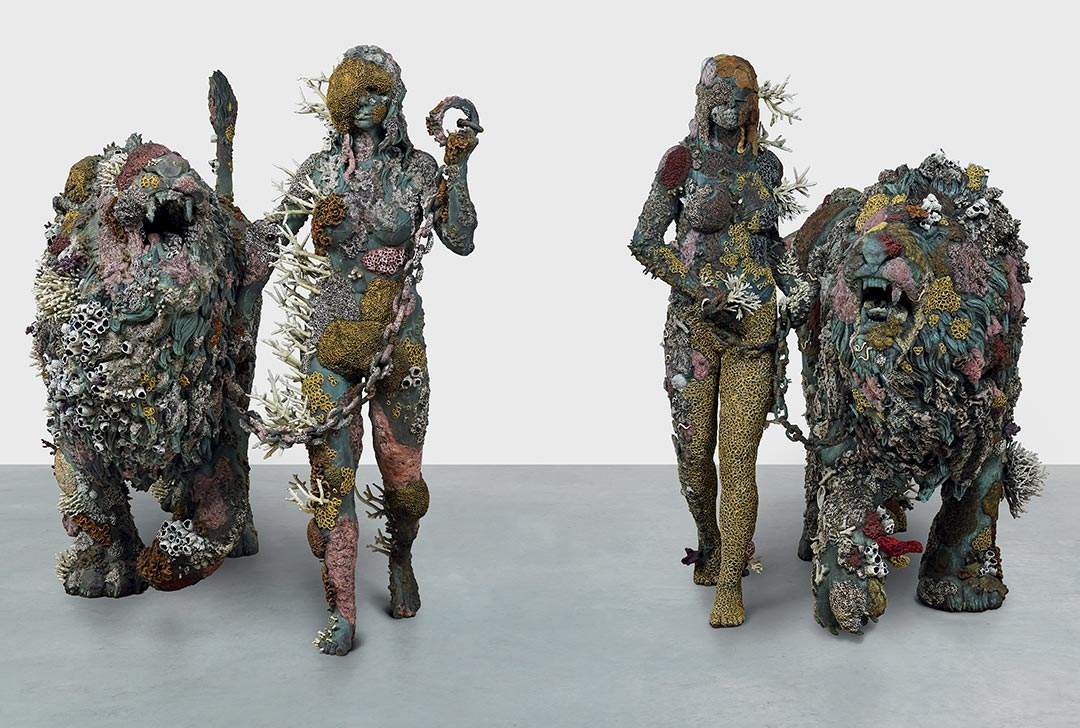Damien Hirst arrives at Rome's Galleria Borghese with an exhibition of 80 works
From June 8 to November 7, 2021, the Galleria Borghese in Rome will host Archaeology Now, a solo exhibition by Damien Hirst (Bristol, 1965), who thus returns to Italy four years after thehuge Treasures from the Wreck of the Unbelievableexhibition held in Venice in 2017 at Palazzo Grassi and Punta della Dogana. The widely announced Roman exhibition is curated by Anna Coliva and Mario Codognato: more than 80 works from the Treasures from the Wreck of the Unbelievable series arrive in Rome, which will be displayed throughout the museum’s halls alongside the ancient works in the collection, and will include both monumental and small-scale sculptures made of materials such as bronze, Carrara marble and malachite.
The Archaeology Now project grew out of Hirst’s research for Treasures from the Wreck of the Unbelievable. For the Venetian exhibition, the British artist had worked with different materials (natural, technological, and precious) to create works in marble, bronze, coral, rock crystal, and semiprecious stones. The idea, a note explains, is to include Hirst’s works “among the masterpieces of the Gallery’s collection” in order to enhance “the desire for multiformity of its founder, Cardinal Scipione Borghese.”
Also arriving for the first time in Italy are paintings from the Colour Space series, which will be installed within the permanent collection. Colour Space constitutes both a development of the Spot Paintings and a revisitation of the first work in that series in which the spots were painted freely. According to Hirst, these paintings are like “cells under a microscope” that break the idea of a unified image, floating in space, colliding and merging into each other, with a sense of movement that contradicts the stasis of the canvas. Finally, the colossal sculpture Hydra and Kali will be in the outdoor space of the Secret Garden of the Bird House.
“Hirst’s works will be presented in the Galleria Borghese, a museum with a superb collection of masterpieces of classical Roman statuary, Italian Renaissance and seventeenth-century painting, and the most important sculptures by Bernini and Canova,” reads the press note, “At the same time, and this is its uniqueness, it is a place that possesses a rich and original decoration made from a variety of materials and colors: marble, stucco, mosaics. Hirst’s works will complement the multiplicity of inventions and techniques in the museum’s collection, showing the artist’s incredible ability to combine concepts and narratives with the exceptional skill required to create these complex works, which has been a constant at this institution.”
Damien Hirst was born in 1965 in Bristol, grew up in Leeds, and studied fine arts at Goldsmiths College, London, from 1986 to 1989. In 1988 he designed and curated Freeze, a group exhibition that became the springboard not only for Hirst but for an entire generation of young British artists. Since the late 1980s, he has made a vast series of installations, sculptures, paintings and drawings to explore the complex relationships between art, beauty, religion, science, life and death. With his works, including the formaldehyde shark The Physical Impossibility of Death in the Mind of Someone Living (1991) and For the Love of God (2007), a platinum cast of a skull studded with 8,601 purest diamonds, he analyzes and challenges the certainties of the contemporary world, and examines all the uncertainties inherent in the nature of man. Since 1987, more than 90 solo exhibitions have been held worldwide and he has participated in more than 300 group exhibitions. In 2012, London’s Tate Modern presented a major retrospective of his work in conjunction with the Cultural Olympiad. Hirst’s solo exhibitions include, among others, Qatar Museums Authority, ALRIWAQ Doha (2013-2014); Palazzo Vecchio, Florence (2010); Oceanographic Museum, Munich (2010); Rijksmuseum, Amsterdam (2008); Astrup Fearnley Museet fur Moderne Kunst, Oslo (2005); Museo Archeologico Nazionale, Naples (2004); Palazzo Grassi and Punta della Dogana in Venice (2017). In 1995 he won the Turner Prize. He lives and works between London, Devon and Gloucestershire.
The exhibition catalog, published by Marsilio in Italian and English versions, features critical texts by Anna Coliva, Mario Codognato, and Geraldine Leardi and contains images of the installation in the museum. The project was made possible thanks to the support of Prada, which investigates areas of research such as art, architecture, philosophy, and literature with the aim of developing innovative languages and projects, in a continuous dialogue with the broader scenarios of contemporaneity.
Pictured: Damien Hirst, Lion women of Asit Mayor
 |
| Damien Hirst arrives at Rome's Galleria Borghese with an exhibition of 80 works |
Warning: the translation into English of the original Italian article was created using automatic tools. We undertake to review all articles, but we do not guarantee the total absence of inaccuracies in the translation due to the program. You can find the original by clicking on the ITA button. If you find any mistake,please contact us.





























